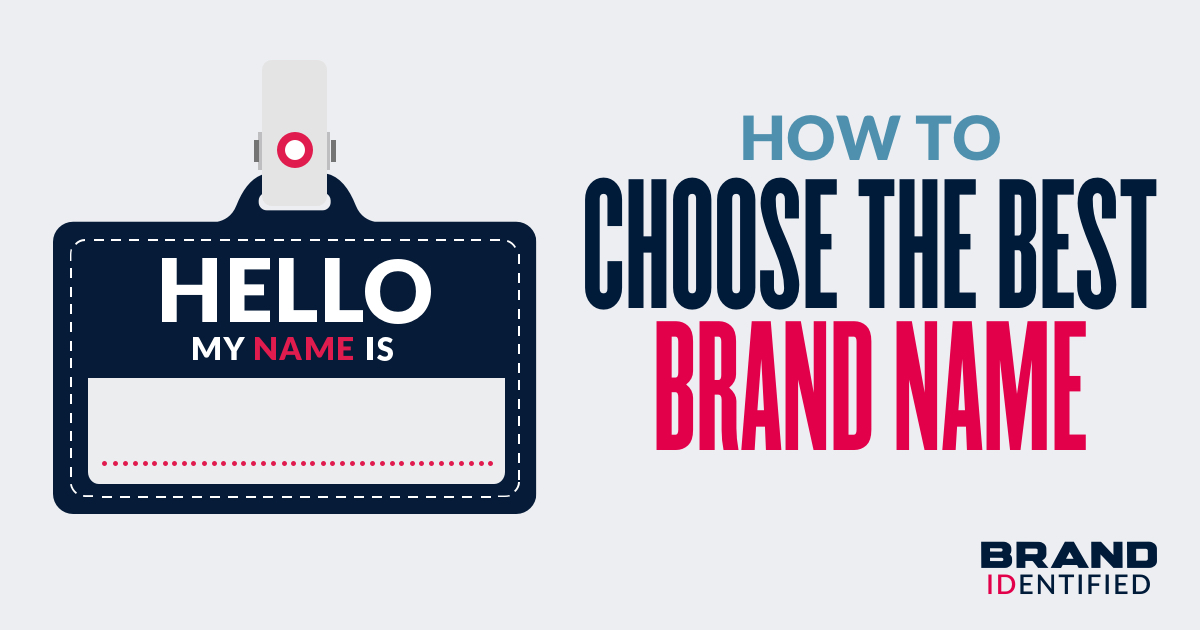How to Choose The Best Brand Name:

But it’s not just something that looks and sounds cool, and you shouldn’t choose a name just because you like it.
Your brand Name is one of the first connection points to capturing the attention of your audience, so it needs to effectively communicate something to the consumer.
Here are just a few questions you should ask yourself and your team during your brainstorming sessions:
- Does the name describe what you do?
- Is the name catchy and easy to remember?
- Does it sound good, and is it easy to pronounce?
- Does it look great in a logo, email subject line, and on a website header?
- Is there an available URL?
- Is the name timeless and allows for future growth?
- Can the name be protected?
- Does it create positive emotions with the consumer?
As you can see, there are several things to consider.
Deciding on a name may be one of the most difficult tasks in creating your brand.
It will require a lot of time, commitment, research, and the dedication of your entire team.
So if you are ready, let’s begin by exploring the qualities that make up a great brand name.
There’s no magic formula or foolproof approach, but there are a few traits of successful brand names that you should follow.
These 6 traits will make your brand name memorable for consumers, and easier for you to use in your marketing.
- Meaningful
Your name should communicate what you do, create a positive emotional connection, support your brand values, and portray the image your brand wants to convey. - Distinctive
Your name should be unique, memorable, and different from the competition. - Accessible
People should be able to easily understand, read, pronunciate, and spell your name. - Protectable
You should be able to trademark and own your name. There should also be a domain name available. - Scalable
Be sure to choose a name that will grow with your company, and can adapt and remain relevant for different products and brand extensions. - Visual
Test out your name in design mockups. Make sure it looks nice and translates well in logos, icons, web applications, and any other design formats you use.
Types of Brand Names
To help make it a bit more manageable, here are 7 popular brand name types to consider and see if they fit with your business.
1: Descriptive Names
These names are very straightforward and basically convey what the business does, or the products and services offered by the company.
They are functional names, but are typically not very exciting, and don’t leave much room for creativity and future expansion.
The benefits of descriptive names is that they clearly communicate the intent of the brand.
However, the disadvantage of this type of name is that as a company grows, it may be difficult to expand and diversify beyond their literal descriptive name.
Examples of the descriptive brand names include:
- The Weather Channel
- Hotels.com
- Bank of America
- General Motors
- Ancestry.com
2: Metaphorical Names
The opposite of a highly descriptive name is a metaphorical name.
These types of names are evocative, creative, and unique.
They leave room for interpretation and enable the brand to emphasize a story that is more engaging than just their products or services.
The benefits of choosing a metaphorical name is that they are usually easy to trademark.
However, since your name is not descriptive and obvious, you will need to rely heavily on your story and marketing to grow your brand.
Examples of the metaphorical brand names include:
- Apple
- Amazon
- Nike
- Tesla
- Virgin
3: Lexical Names
If you are feeling especially clever, but not corny, you can create a Lexical name for your brand.
Lexical names represent a play on words.
They either alter the spelling of words to create something unique and memorable, or they combine two words to form a single word name.
Although these names can be fun, be careful not to play off of puns that could be interpreted as unprofessional and repel your audience.
Examples of the lexical brand names include:
- Flickr
- Tumblr
- Dunkin’ Donuts
- Krazy Glue
- FedEx
4: Acronym Names
An Acronym is an abbreviation formed from the initial letters of other words and pronounced as a word.
This type of name has been successful for some businesses, however in my opinion the difficulties associated with an acronymic name outweigh the benefits.
For example, acronyms are difficult for the consumer to learn and remember.
They also lack any meaning or emotion.
And as you’ve already learned, the success of your brand relies heavily on the connection it makes with the consumer.
With that said, here are examples of brands who have founds great success using the acronymic names:
- IBM
- UPS
- BMW
- MTV
- GE
5: Founder Names
Some of the most successful and incredible brands in the world were named after their founders.
These names are usually easy to trademark and protect.
But remember that a brand named after a founder will always be directly connected to that human and their actions.
Examples of the founder brand names include:
- Ford
- Ben & Jerry’s
- Disney
- Ralph Lauren
- Calvin Klein
6: Geographical Names
Perhaps you want to connect your business to the location where it was started.
Geographical names will always instill the brand with whatever culture and historical association the consumer perceives of that region – both good and bad.
Even though you may be proud of your roots and want to show your appreciation to the location that helped you succeed, naming or renaming your brand after it’s home will have its limitations when attempting to expand beyond that region.
Examples of the geographical brand names include:
- California Pizza Kitchen
- New York Life
- Kentucky Fried Chicken
- Florida’s Natural
- American Airlines
7: Invented
If all else fails, you can just make up a name.
Invented names are purley fabricated.
They have no connection to the business or the products and services the company offers.
An invented name is usually easy to trademark, and a domain will most likely be available.
This type of name may seem like a simpler solution to the other alternatives, but they are not as easy to conjure up as you may think.
You have to consider how it’s spoken, it’s cadence, how it looks when written, what it may mean in other cultures, and if there are any negative connotations with how it sounds.
But if done right, invented names can be very powerful and allow your brand to be flexible and adapt in the future.
Examples of Invented brand names are:
- Exxon
- Verizon
- Adidas
- Pixar
As you can see, each brand type has its own pros and cons, and some will always be more effective than others.
Whatever type of brand name you decide on, it’s important to define expectations to your team prior to beginning the process.
Renaming Your Brand
Perhaps you weren’t aware of how critical your name is in the success of your business.
- Does your current name hold up?
- Does it represent your business?
- Does it attract consumers?
- Does it look and sound good?
- Does it allow for growth?
It’s ok if you answered no to any of these questions.
Renaming can be an exciting and rewarding endeavor, because it can open up an entire new world of possibilities for your business.
But before you make any rash decisions and completely throw out your name and start over, let’s assess the situation.
Here are 5 reasons why you may want to consider a rename:
1: You’ve outgrown your name
Although a name change will take a significant amount of time and effort, if you’ve outgrown your name it’s usually an indication that you’re doing something right.
10 or 20 years ago when you started your business, your name may have been the perfect fit.
It described what you did, it aligned with your values, and it connected with your audience.
However, now you’ve grown, and perhaps your current name is dated and no longer reflects the positive experience you provide for your customers.
2: Your name doesn’t stand out
Have you gotten lost in the marketplace? Does your name look and sound just like every other competitor in your industry?
What may have initially been a unique and memorable name, is now just another generic name on the shelf.
If your name no longer draws attention and attracts the consumer’s eye. It may be time for a name change.
3: You’re being legally forced to
This is a tough one. When you choose names in your brainstorming sessions, one of the first steps is to determine if the name, or similarities, are already being used.
Be sure to check all trademarks, copyrights, social media, competitor products, and URLs.
If you fail to complete this critical step, you may not have a choice in changing your name.
4: You’re experiencing a public relations conflict
Sometimes world events or the actions of others that are completely out of your control will force you to make a quick and necessary change.
Perhaps your chosen brand name has negative connotations in another culture.
Or maybe your name is similar to the name of a high profile individual who has fallen from grace.
Whatever the situation, any negativity in the public eye will require a name change.
5: You’ve expanded beyond your geographical name
Remember earlier when I described the geographical name type?
Maybe that regional name that worked so well 5 years ago no longer represents your success and growth.
Some brands like California Pizza Kitchen and American Airlines have been able to expand beyond their original location and keep their name.
You may be able to as well, but be sure to assess both the positives and negatives with a name change.
The last thing you want to do is cause confusion and create a disconnect with your current audience.
Well there you have it. I’ve provided you with all the information you need to begin your brand naming process.
All that’s left now is for you and your team to get to work.
How to Choose Your Brand Name
Step 1: Articulate (Purpose, Vision, Mission, and Values)
Before you begin choosing names, you must first have a well defined brand.
If you have not already done so, be sure you have completed your Brand Purpose, your Brand Vision, your Brand Mission, and your Brand Values.
Then be sure they are articulated in your name choices.
Step 2: Differentiate
Carving out your spot in the marketplace relies heavily on how you differentiate yourself from the competition.
Understanding what makes you unique is a critical component in finding your name.
Remember, you’re looking for a great name that represents your specific brand, not just a good name.
So be sure to look at the names of your competitors and choose a name that makes you stand out.
Step 3: Brainstorm
This is the fun part!
Gather up your team and start throwing out some ideas.
This should be a free, open, and creative environment.
Remember, in this process there are no bad ideas.
However, you should put some criteria in place to keep the brainstorming session on track.
Be sure that you and your team are suggesting names based on your brand purpose, vision, and core values.
Always keep your audience in mind. What do you want your customers to think and feel when they use your products or services?
Aim for you and your team to come up with 15-20 name ideas.
Step 4: Vet
Next is the most disappointing and frustrating part of brainstorming name ideas.
Just when you think you have found a name that describes your brand perfectly, connects with your audience, and represents your core values ….. You do a quick google or trademark search and discover that it has already been taken.
But it’s always better to find this out now rather than later.
So be sure that with every name idea you come up with, you do a simple google search, a search of the United States Patent and Trademark Office’s database, as well as social media sites.
Step 5: Refinement
Hopefully after the vetting stage you still have about 10-15 names to choose from.
Now it’s time to trim the fat by further analyzing each name.
Once again, review your brand purpose, vision, mission, and values to confirm that each of these names supports them.
- Which names connect best with the needs of the customer?
- How does the name sound when spoken?
- Will it look good on a business card or website?
Try to narrow your list down to your top 5.
Step 6: Testing
Let’s see how all these final names actually look when applied to designs
- Create some basic logo mockups.
- Place the name on a landing page.
- See how it looks in an email subject line.
- Design a quick business card with each name.
Don’t worry about colors and typography at this point, we’ll address those later when we design your visual identity.
Right now you should only be concerned with how the name looks and feels on it’s own, without any embellishments to distract you.
You may be surprised at how some of the names you thought were your top choices don’t look quite right visually.
Step 7: Choose
It’s now time to make your final selection.
Which can be a very difficult decision to make.
After all, your name has the potential to either make or break your brand.
But if you have done everything I’ve suggested, you should be able to make an intuitive and educated decision based on the name that best aligns with everything your business represents.
To continue your training, please be sure to download the FREE Brand Builder Toolbox and complete the Action Guide.
CLICK HERE to Learn More >>
Get Started Now To Receive Your...
Unlock Unlimited Growth Today!



